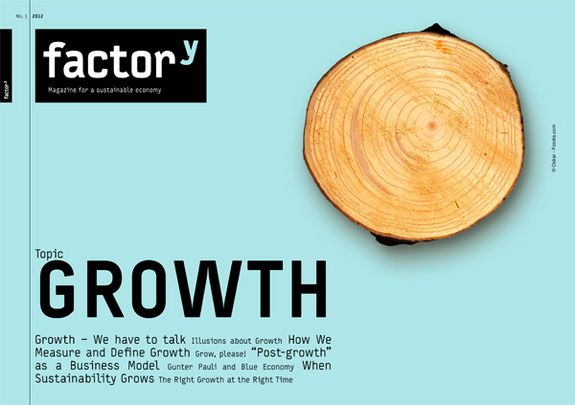Growth


They do exist, the 'limits to growth'. Everyone is familiar with the key words nowadays: climate change, overexploited oceans and high oil prices. If you ask companies and politicians about this, they quickly start talking about competitiveness. Without growth, individual companies as well as entire economies would quickly be out of business. Ecologists counter that continual growth will also lead to collapse – it will just take longer. Both of them are right.
By Bert Beyers
Translated from the German by Theresa Lupek, Alina Junk and Larissa Katja Burkart
What’s the deal with growth?
Growth has something to do with increase, enlargement, development, augmentation, expansion, and extension. It is all about getting more.
Economically speaking, growth is usually defined as the percentage increase in gross domestic product, i.e. the annual increase in the total value of all goods and services produced by an economy. This, however, disregards important factors. Meanwhile, growth often occurs at the expense of natural living conditions. Thus, we are losing sight of the actual goal of economy: the quality of life.
The era of hyper-growth
Around 1950, there were about 2.5 billion people living on earth. Today there are about seven billion. In the second half of the 20th century, the economy expanded at the same explosive rate, the global gross domestic product increased sevenfold. The two World Wars were followed by three decades that historians refer to as the ‘Golden Age’. In Europe, North America and Japan, broad levels of population experienced the kind of prosperity that had been reserved for millionaires only in the days of their grandparents, like telephones, washing machines and cars. In the second half of the 20th century, global water consumption tripled, carbon dioxide emissions quadrupled and commercial fishing quintupled.
Can economic growth last?
Of course it can. By 2050, the world population will have grown to between nine and ten billion people. By the middle of the century, the world population will most likely have reached its climax. China and India alone will then each have reached a population of 1.5 billion people, which is more than the total world population was in 1950. People in China, India and Brazil also want telephones, washing machines and cars. As we get closer to the year 2050, we will not only be experiencing growth, but also increasingly our limits.
Limits to growth
In terms of the climate issue, the world is in a difficult situation. The rapid growth in the global population, the increasing prosperity of a 'middle class' in densely populated emerging markets as well as energy that is predominantly generated from fossil fuels have an impact on the current situation. There is no chance of preventing an increase in the earth’s average temperature by about 2° Celsius. If we were really to reach this goal, the man-made greenhouse gas emissions would have to be reduced to about one third by 2050, which would be very ambitious.
There will be a completely different trend up until the middle of the 21st century with respect to the economic growth process and the comparatively low energy efficiency in countries like China, India or Brazil. Instead of reducing today’s emissions to 30%, there will be a significant increase with nearly doubled emissions. If this were to actually take place, the ultimate climate disaster could no longer be prevented. The consequences would be much more severe than those of a global financial crisis, which could be overcome within a few years’ time. Restoring the global climate system, however, would take ten 10,000 years or even more.
So far, we have not even talked about peak oil (the imminent point in time when the global oil production reaches its maximum rate), unprecedented losses of biodiversity, the collapse of fish stocks, water scarcity in many parts of the world or the global loss of fertile soil. There is no point in denying the fact that there are limits to ecosystems.
The REBound effect
Technological progress brought about unprecedented opportunities. The ability to make fire opened up a much larger environment to humankind, thus providing a broader variety of food. From the Neolithic revolution about 10,000 years ago to the so-called Green Revolution of the modern day, the yield of agricultural land has increased drastically. The fact that we can feed seven billion people today is a direct consequence of technological progress.
The so-called rebound effect is considered to be the antithesis of technological progress. In the middle of the 19th century, the British economist Stanley Jevons was the first to ever describe this phenomenon (Jevons Paradox): “It is wholly a confusion of ideas to suppose that the economical use of fuel is equivalent to a diminished consumption. The very contrary is the truth. As a rule, new modes of economy will lead to an increase of consumption according to a principle recognized in many parallel instances.” James Watt’s steam engine was approximately seventeen times more energy-efficient than previous models, but it was also responsible for an enormous increase in coal consumption.
What does this mean?
In terms of figures, annual growth of 3% means a doubling of goods and services every 23 years, a thousand-fold increase within 234 years. Thus, even in the long run, it does not help to reduce the amount of waste generated per unit of industrial products. If we examine the figures, we can easily see that this process will and must end at some point.
The only way is to strictly incorporate the ‘limits to growth’ in economic regulations, and this needs to be done on a global level. This is difficult, but not impossible. Regarding climate, there are annual limits on the emission of greenhouse gases. In terms of fishing, there are fishing quotas and if we really want to preserve parts of biodiversity, certain regions simply should not be used for commercial purposes. No ifs and buts. The rebound effect would be leveraged in just one step. Within these framework conditions, competition would then ensure effective and ‘dematerialized’ solutions and thus, a global socio-economic market economy.
Meanwhile, developed countries start to realize that growth cannot be perpetuated with credits – a painful farewell is imminent.
News zum Thema
- 10/2016 | European Resources Forum (ERF) on 9 – 10 November 2016
- 10/2016 | Environmental tax reform for climate protection and social justice
- 07/2016 | Planetary Urbanism – The Transformative Power of Cities in 50 Selected Works
- 11/2015 | The Hope for COP
- 10/2015 | If a major economy takes the lead, warming could be limited to 2°C
- 06/2014 | 2013 is another Record Year for Renewables
- 05/2014 | "Growth" issue now available
- 10/2013 | Germany could be greenhouse-gas-neutral by 2050
- 01/2013 | For a Better Energy Efficiency Policy
- 01/2013 | A New Way of Assessing our Economies: The Prosperity Quintet
Themen
- The Domino Effect: the Mobility Transition as an Engine for the ‘Great Transformation’
- Cities Use the Space
- Decarbonization by 2030
- The fear of biting the hand that feeds you
- Where investing is a pleasure
- Why divestment is going to change the world
- A Robin Hood tax for climate protection
- May the Force Be with Us
- Modern Strategies
- The prerogative of interpreting the future now lies with the companies involved in climate protection”
- From Negotiating to Trading Equitably
- Can a donkey be tragic?
- Rethink rather than rebound: a sufficiency revolution must precede the efficiency revolution
- On Rebound, Prebound and Performance Gaps
- So Let Us Seize Power Then!
- With Common Property Against Political Failure
- So Let Us Seize Power Then!
- The Comforting Beauty of Failure
- “It Is Not Impossible at All.“
- Resource-light shopping
- Men Have Not Stopped Giving the Advantage to Women – So Far
- Toothpaste for Princesses and Soup for Pirates
- It is about equality
- A nice day
- Initiative instead of frustration
- The right ingredients
- Resilient for Life
- Not only, but also
- Appreciation – more please!
- Worth more than money
- Learning to value the value of goods
- Worth and Values
- The Transformative Power of Science
- Historically effective: How innovation and technology transform
- The Disappearance of Products
- Growing Older 101
- Columbus’ Egg
- It Works! In Theory at Least ...
- What If...?
- Analysing Separately – Thinking and Acting Together!
- Let’s Break Away from Determined Breaking Points
- More Gold in Waste than in Mines
- The art of separation
- Should you really DIY?
- The Aesthetics of Do-It-Yourself
- Standing on One’s Own Feet
- From the handaxe to desktop fabrication
- Using Shares to Survive the Crisis
- When Citizens participate
- Possess to Participate
- The Right Growth at the Right Time
- Gunter Pauli and Blue Economy
- When Sustainability Grows
- How we treat Growth
- Illusions about Growth


